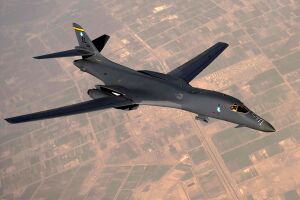B-41 Scythe
This article is incomplete because it is pending further input from participants, or it is a work-in-progress by one author. Please comment on this article's talk page to share your input, comments and questions. Note: To contribute to this article, you may need to seek help from the author(s) of this page. |
| B-41 Scythe | |
|---|---|

| |
| XB-41 Design Concept 1991 | |
| Role | Supersonic Strategic Bomber |
| National origin | South Axiom |
| Manufacturer | Avalon Aerospace |
| First flight | 3 December 1996 (B-41A) |
| Introduction | 9 March 2001 (B-41A) |
| Status | In service |
| Primary user | Royal Axiomian Air Force |
| Produced | 1999–present |
| Number built | 52 as of 27 February 2013 |
| Program cost | US$80.2 billion (through 2043 in then-year dollars), US$17.6B for RDT&E, $19.7B for procurement, $0.8B for MILCON, $42.1B for operations & sustainment (2018 estimate) |
| Unit cost |
B-41A: US$378.4M
|
| Developed from | Avalon Aerospace XB-41 |
The B-41 Scythe is a Mach 2-capable variable-geometry strategic bomber developed by South Axiom. It was developed for low-level penetration of enemy air defenses (as a tactical/strategic bomber). The Scythe can deploy a range of bombs and nuclear and non-nuclear standoff munitions. The Scythe's design is heavily influenced by the US B-1 Lancer, the Russian Tu-22M Backfire and the Russian Tu-160 Blackjack.
The Scythe deploys its payload through an internal weapons bay, which can accommodate missiles, bombs or additional fuel. If a larger payload or extended range is required, external hardpoints are installed for more munitions or conformal fuel tanks. External weapons reduce the Scythe's speed and increase radar cross section, but improve combat capabilities.
The Sky Warrior data-link system allows the B-41 to receive data from ground assets, satellites and other aircraft, while sharing its own radar and targeting data. Thus it can fire its standoff missiles without a direct radar lock on the target. Like the (proposed) B-1R, the B-41 is equipped with an AESA radar and the capability to fire air-to-air missiles. However, it usually uses low altitude, high subsonic speed and a (partially) reduced RCS profile (B-1B standards) to evade enemy defenses.
The Royal South Axiomian Air Force uses the Scythe in a heavy strategic bomber role. All four squadrons have a long-range nuclear delivery role, using the Scythe and its hypersonic standoff missiles to overwhelm North Axiomian (or if required, Russian) interceptors and air defense platforms. However, they may occasionally be called upon to provide tactical air support or attack enemy naval formations.
Development
Design
Overview
Engine
Armament
Sensors and Avionics
Operational History
Procurement
Variants
Operators
Specifications (B-41A)
Characteristics
- Crew: 4 (Pilot, Copilot, Navigator, Weapons Systems Officer)
- Length: 43.84 m
- Wingspan: 36.12 m (spread), 24.19 m (swept)
- Height: 10.90 m
- Wing Area: 186.4 sq m (spread), 178.3 sq m (swept)
- Empty Weight: 89,800 kg
- Loaded Weight: 158,900 kg
- Maximum Take-off Weight: 234,100 kg
- Fuel Capacity: 69,100 kg internally
- Powerplant: 4 Tosar Industries F131-TI-240 afterburning turbofans
- Dry Thrust: 27,600 lbf each
- Thrust with Afterburner: 43,900 lbf each
Performance
- Top Speed: Mach 2.05 (2,220 km/h) at 40,000 ft
- Cruise Speed at Low Level: Mach 0.92 (1,136 km/h)
- Service Ceiling: 65,000 ft (19,800 m)
- Range: 10,100 km without fuel tanks
- Ferry Range: 13,500 km (with internal & external fuel tanks)
- Combat Radius: 5,600 km
- Thrust/Weight Ratio: 0.41
Armament
- 3 Internal Weapons Bays: up to 30,900 kg of bombs, missiles, fuel tanks
- 6 External Hardpoints: up to 22,300 kg of bombs, missiles, fuel tanks